Reproduction of the Marine Debris Distribution in the Seto Inland Sea Immediately after the July 2018 Heavy Rains in Western Japan Using Multidate Landsat-8 Data
Abstract
:1. Introduction
2. Materials and Methods
2.1. Study Area and Landsat-8 Data
2.2. Spectral Reflectance Data of Marine Debris
2.3. Extraction of Marine Debris from Satellite Data
- Obtain the histogram of the cFAI image.
- Calculate the minimum value (Imin), maximum value (Imax), and average value (μ0) from the histogram.
- Determine an appropriate threshold value T within the range of Imin and Imax.
- Divide the histogram into two classes according to the threshold value T.
- Obtain the variance ( and ), average (µ1 and µ2), and number of pixels (n1 and n2).
- Obtain the intraclass variance and the interclass variance from the following equations.
- From the two variances obtained in step 6, the degree of separation S of the following equation is obtained.
- Repeat steps 4 to 6 to find all T values with a degree of separation S within the range of minimum to maximum.
- The T when the degree of separation S reaches its maximum is determined as the threshold value and is used for binarization processing.
3. Results
3.1. Marine Debris Collection Status by Cleaning Ships
3.2. Spectral Characteristics of Marine Debris
3.3. Marine Debris Detection Results Obtained Using Satellite Data
4. Discussion
4.1. Validity of the FAI-Based Method for Marine Debris Detection
4.2. Validity of Marine Debris Detection by cFAI and Otsu Methods
4.3. Reason for Change in the Amount of Marine Debris Detected
4.4. Limitations of Marine Debris Detection Using Landsat-8 Data
5. Conclusions
- From the data acquired by the cleaning ships on multiple days, the distribution of marine debris immediately after the heavy rain was approximated. In particular, the debris was concentrated in the water area surrounded by land and islands in the northern part of Aki Nada.
- From the spectral reflectance data of Landsat-8 level-2, we confirmed that the marine debris had a high peak reflectance in band 5 (central wavelength 865 nm).
- Unlike the original FAI method, the cFAI method enabled us to remove the background water signals from the Landsat-8 images.
- The Otsu method for the automatic binarization of cFAI was effective in detecting marine debris from Landsat-8 images because it set an appropriate threshold value.
Author Contributions
Funding
Acknowledgments
Conflicts of Interest
Appendix A


References
- Tsuguti, H.; Seino, N.; Kawase, H.; Imada, Y.; Nakaegawa, T.; Takayabu, I. Meteorological overview and mesoscale characteristics of the Heavy Rain Event of July 2018 in Japan. Landslides 2019, 16, 363–371. [Google Scholar] [CrossRef]
- Hirota, K.; Konagai, K.; Sassa, K.; Dang, K.; Yoshinaga, Y.; Wakita, E.K. Landslides triggered by the West Japan Heavy Rain of July 2018, and geological and geomorphological features of soaked mountain slopes. Landslides 2019, 16, 189–194. [Google Scholar] [CrossRef]
- Opfer, S.; Arthur, C.; Lippiatt, S. NOAA Marine Debris Shoreline Survey Field Guide; NOAA Marine Debris Program: Silver Spring, MD, USA, 2012. [Google Scholar]
- Moy, K.; Neilson, B.; Chung, A.; Meadows, A.; Castrence, M.; Ambagis, S.; Davidson, K. Mapping coastal marine debris using aerial imagery and spatial analysis. Mar. Pollut. Bull. 2012, 132, 52–59. [Google Scholar] [CrossRef]
- Kubota, M. A mechanism for the accumulation of floating marine debris north of Hawaii. J. Phys. Oceanogr. 2019, 24, 1059–1064. [Google Scholar] [CrossRef]
- Isobe, A.; Iwasaki, S.; Uchida, K.; Tokai, T. Abundance of non-conservative microplastics in the upper ocean from 1957 to 2066. Nat. Commun. 2019, 10, 417. [Google Scholar] [CrossRef] [PubMed] [Green Version]
- Komatsu, T.; Sagawa, T.; Sawayama, S.; Tanoue, H.; Mohri, A.; Sakanishi, Y. Mapping is a key for sustainable development of coastal waters: Examples of seagrass beds and aquaculture facilities in Japan with use of ALOS images. In Sustainable Development: Education, Business and Management—Architecture and Building Construction—Agriculture and Food Security; Books on Demand: Norderstedt, Germany, 2012; pp. 145–160. [Google Scholar]
- Murata, H.; Komatsub, T.; Yonezawac, C. Detection and discrimination of aquacultural facilities in Matsushima Bay, Japan, for integrated coastal zone management and marine spatial planning using full polarimetric L-band airborne synthetic aperture radar 5. Int. J. Remote Sens. 2019, 40, 5141–5157. [Google Scholar] [CrossRef]
- Hu, C. A novel ocean color index to detect floating algae in the global oceans. Remote Sens. Environ. 2009, 113, 2118–2129. [Google Scholar] [CrossRef]
- Hu, C.; Li, D.; Chen, C.; Ge, J.; Muller-Karger, F.E.; Liu, J.; Yu, F.; He, M.X. On the recurrent Ulva prolifera blooms in the Yellow Sea and East China Sea. J. Geophys. Res. 2010, 115, C05017. [Google Scholar] [CrossRef] [Green Version]
- Cózar, A.; Aliani, S.; Basurko, O.C.; Arias, M.; Isobe, A.; Topouzelis, K.; Rubio, A.; Morales-Caselles, C. Marine litter windrows: A strategic target to understand and manage the ocean plastic pollution. Front. Mar. Sci. 2021, 8, 571796. [Google Scholar] [CrossRef]
- Sato, H.; Takeda, K.; Matsumoto, K.; Anai, H.; Yamakage, Y. Efforts for disaster prevention/mitigation to protect society from major natural disasters. Fujitsu Sci. Tech. J. 2016, 52, 107–113. [Google Scholar]
- Cheng, J.W.; Mitomo, H. Multi-channel information dissemination for disaster evacuees–the case of the 2016 Kumamoto Earthquake in Japan. In Proceedings of the 29th ITS European Conference, Trento, Italy, 1–4 August 2018. [Google Scholar]
- Garcia, R.A.; Fearns, P.; Keesing, J.K.; Liu, D. Quantification of floating macroalgae blooms using the scaled algae index. J. Geophys. Res. 2013, 118, 26–42. [Google Scholar] [CrossRef] [Green Version]
- Hu, L.; Zeng, K.; Hu, C.; He, M.X. On the remote estimation of Ulva prolifera areal coverage and biomass. Remote Sens. Environ. 2019, 223, 194–207. [Google Scholar] [CrossRef]
- Takasugi, Y.; Hoshika, A.; Noguchi, H.; Tanimoto, T. The role of tidal vortices in material transport around straits. J. Oceanogr. 1994, 50, 65–80. [Google Scholar] [CrossRef]
- Takeoka, H. Progress in Seto Inland Sea research. J. Oceanogr. 2002, 58, 93–107. [Google Scholar] [CrossRef]
- Hashimoto, R.; Tsuchida, T.; Moriwaki, T.; Kano, S. Hiroshima Prefecture geo-disasters due to Western Japan Torrential rainfall in July 2018. Soils Found. 2020, 60, 283–299. [Google Scholar] [CrossRef]
- Garaba, S.P.; Dierssen, H.M. Hyperspectral ultraviolet to shortwave infrared characteristics of marine-harvested, washed-ashore and virgin plastics. Earth Syst. Sci. Data 2020, 12, 77–86. [Google Scholar] [CrossRef] [Green Version]
- Moshtaghi, M.; Knaeps, E.; Sterckx, S.; Garaba, S.; Meire, D. Spectral reflectance of marine macroplastics in the VNIR and SWIR measured in a controlled environment. Sci. Rep. 2021, 11, 5436. [Google Scholar] [CrossRef]
- Otsu, N. A threshold selection method from gray-level histograms. IEEE Trans. Syst. Man. Cybern. 1979, 9, 62–66. [Google Scholar] [CrossRef] [Green Version]
- Oyama, Y.; Matsushita, B.; Fukushima, T. Distinguishing surface cyanobacterial blooms and aquatic macrophytes using Landsat/TM and ETM+ shortwave infrared bands. Remote Sens. Environ. 2015, 157, 35–47. [Google Scholar] [CrossRef]
- Biermann, L.; Clewley, D.; Martinez-Vicente, V.; Topouzelis, K. Finding plastic patches in coastal waters using optical satellite data. Sci. Rep. 2020, 10, 5364. [Google Scholar] [CrossRef] [PubMed] [Green Version]
- Son, Y.B.; Choi, B.J.; Kim, Y.H.; Park, Y.G. Tracing floating green algae blooms in the Yellow Sea and the East China Sea using GOCI satellite data and Lagrangian transport simulations. Remote Sens. Environ. 2015, 156, 21–33. [Google Scholar] [CrossRef]
- Qiu, Z.; Li, Z.; Bilal, M.; Wang, S.; Sun, D.; Chen, Y. Automatic method to monitor floating macroalgae blooms based on multilayer perceptron: Case study of Yellow Sea using GOCI images. Opt. Express 2018, 26, 26810–26829. [Google Scholar] [CrossRef] [PubMed]
- Qi, L.; Hu, C.; Mikelsons, K.; Wang, M.; Lance, V.; Sun, S.; Barnes, B.B.; Zhao, J.; Van der Zande, D. In search of floating algae and other organisms in global oceans and lakes. Remote Sens. Environ. 2020, 239, 111659. [Google Scholar] [CrossRef]


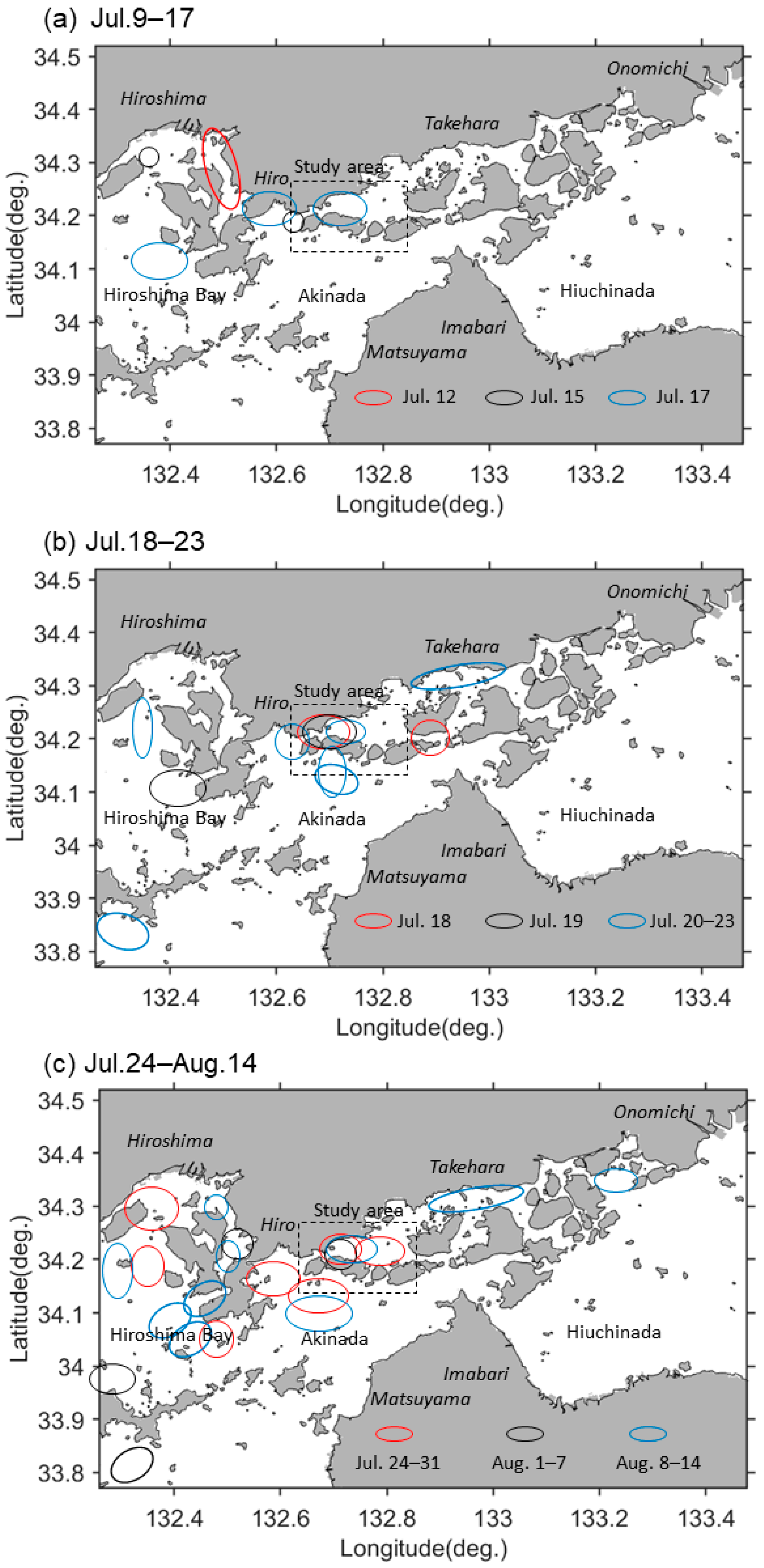
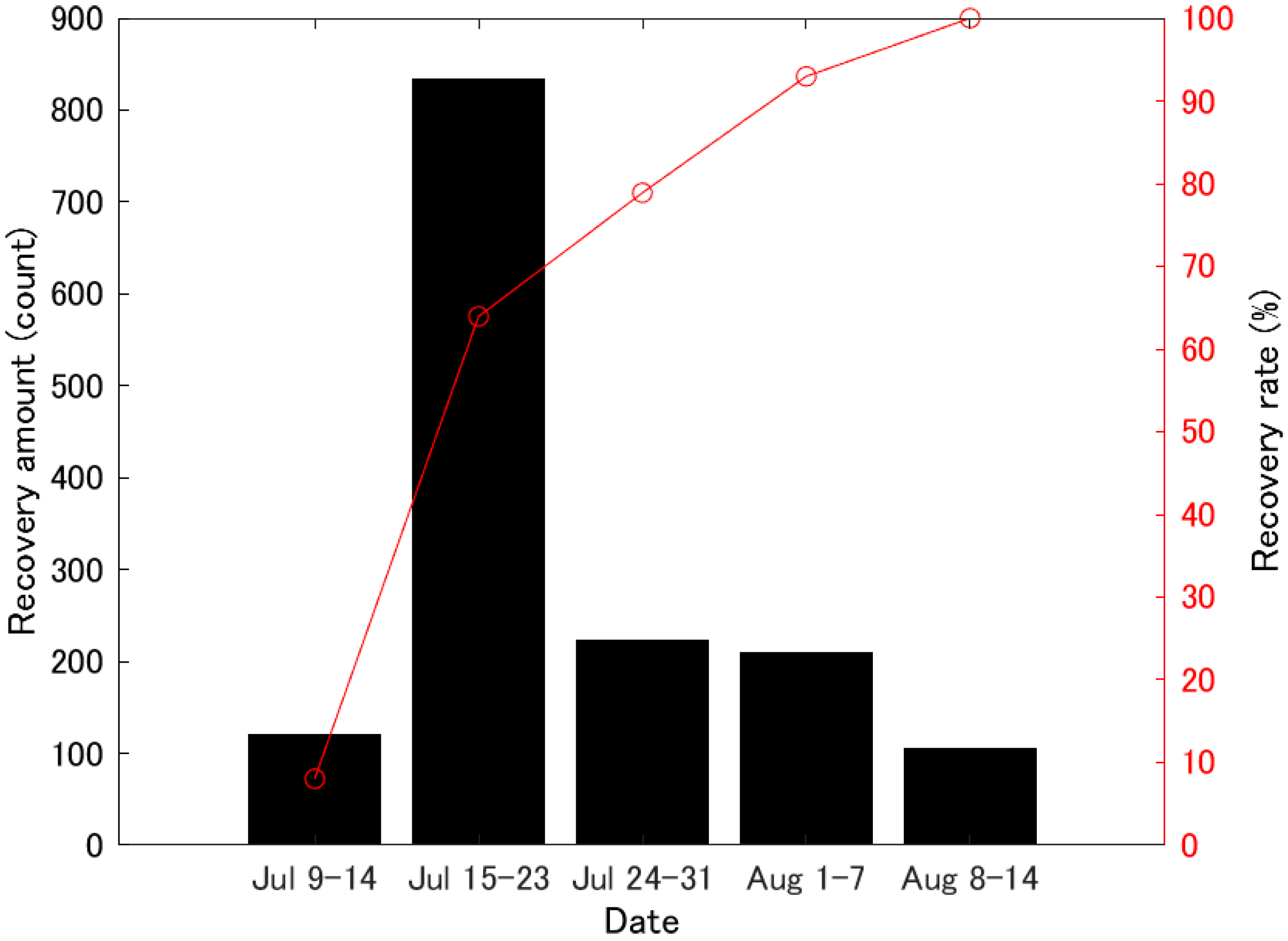
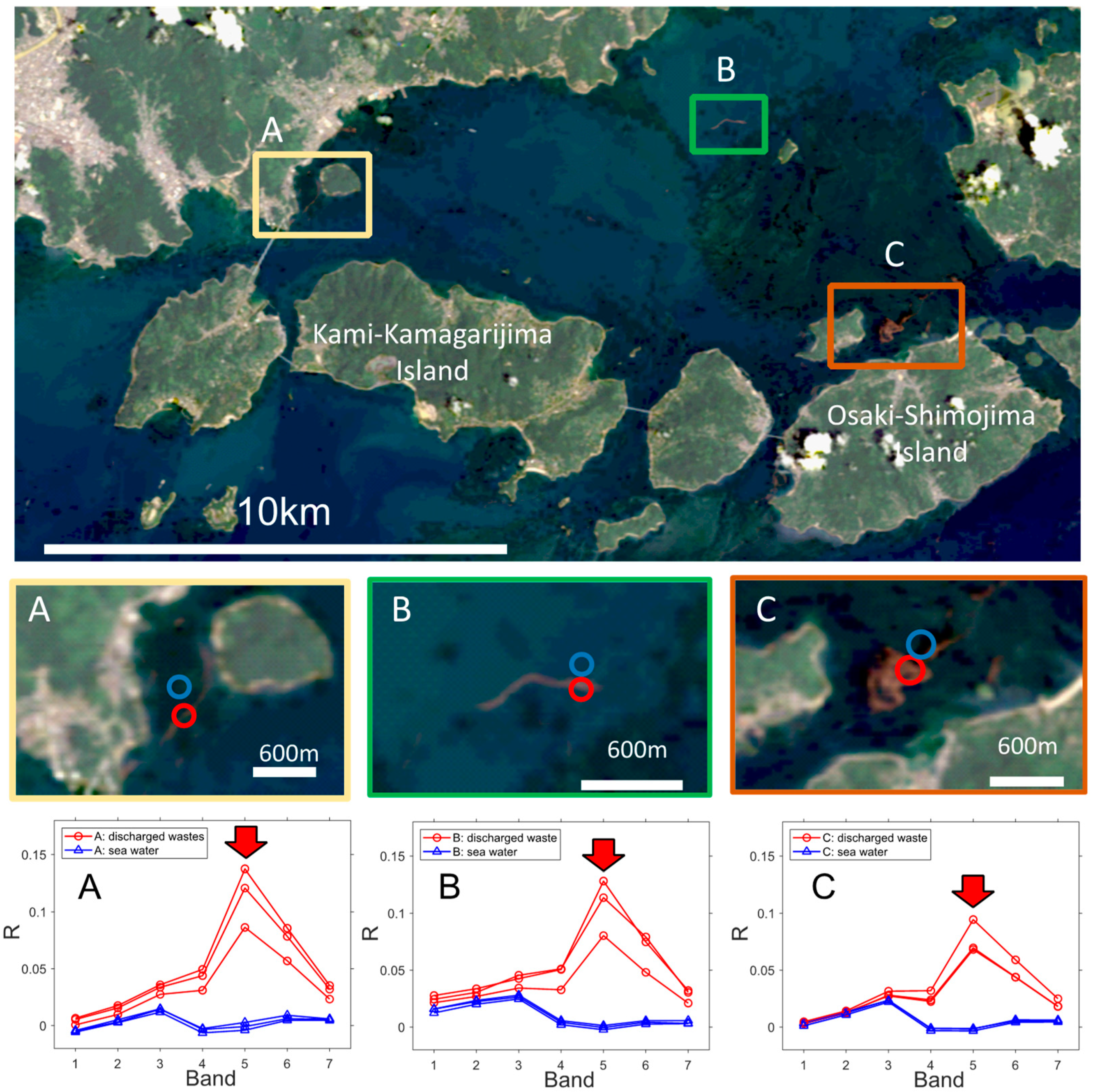
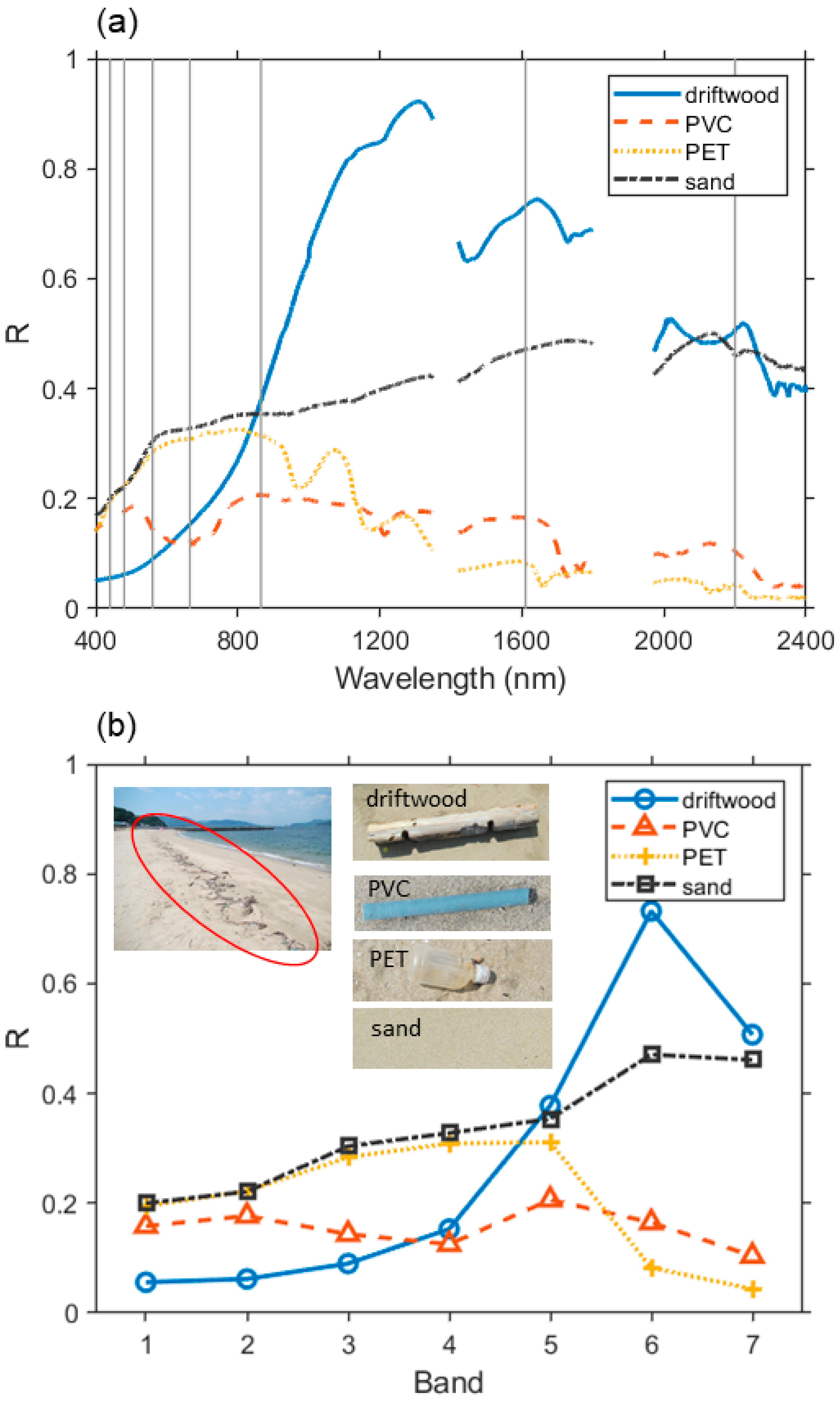
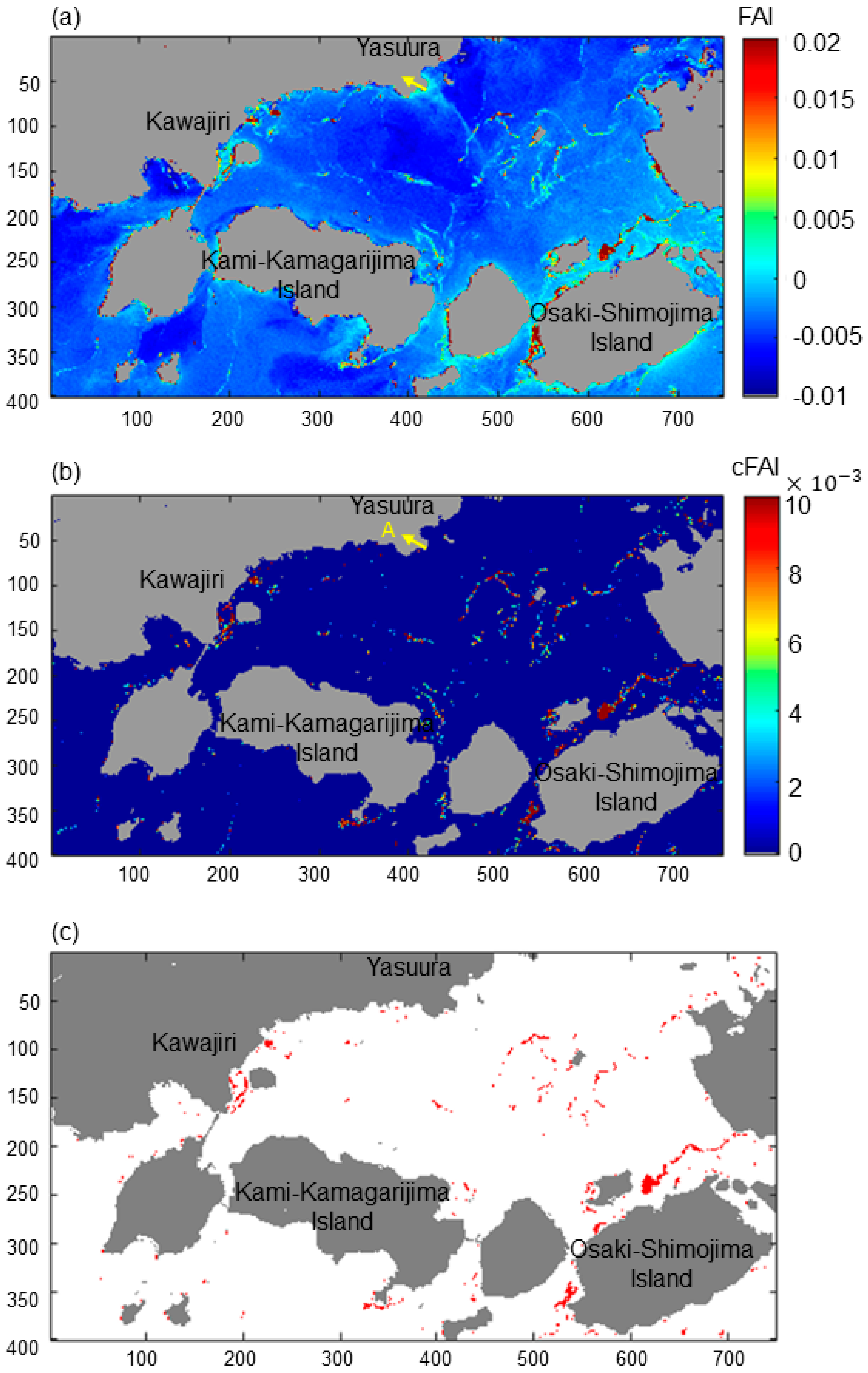

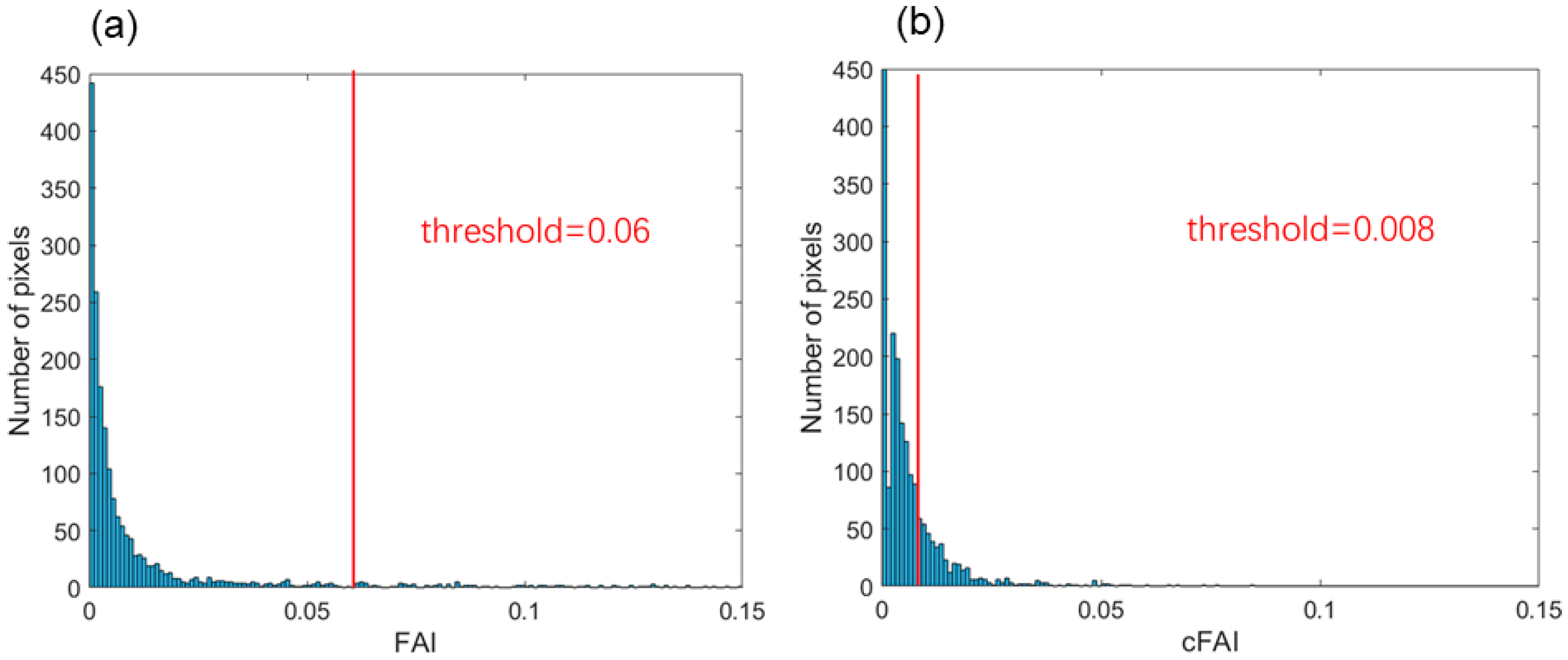

| Band | Wavelength (μm) | Spatial Resolution (m) |
|---|---|---|
| 1 | 0.43–0.45 | 30 |
| 2 | 0.45–0.51 | 30 |
| 3 | 0.53–0.59 | 30 |
| 4 | 0.64–0.67 | 30 |
| 5 | 0.85–0.88 | 30 |
| 6 | 1.57–1.65 | 30 |
| 7 | 2.11–2.29 | 30 |
| Publication Date | Evidence Material |
|---|---|
| 13 July 2018 | https://www.cgr.mlit.go.jp/kisha/2018jul/180713-8top.pdf |
| 16 July 2018 | https://www.mlit.go.jp/common/001245276.pdf |
| 17 July 2018 | https://www.cgr.mlit.go.jp/kisha/2018jul/180717-5top.pdf |
| 18 July 2018 | https://www.cgr.mlit.go.jp/kisha/2018jul/180718-2top.pdf |
| 19 July 2018 | https://www.cgr.mlit.go.jp/kisha/2018jul/180719-4top.pdf |
| 21 July 2018 | https://www.cgr.mlit.go.jp/kisha/2018jul/180721-3top.pdf |
| 22 July 2018 | https://www.cgr.mlit.go.jp/kisha/2018jul/180722-2top.pdf |
| https://www.cgr.mlit.go.jp/kisha/2018jul/180722-3top.pdf | |
| 24 July 2018 | https://www.cgr.mlit.go.jp/kisha/2018jul/180724-1top.pdf |
| 25 July 2018 | https://www.cgr.mlit.go.jp/kisha/2018jul/180725-4top.pdf |
| 1 August 2018 | https://www.cgr.mlit.go.jp/kisha/2018aug/180801-2top.pdf |
| 8 August 2018 | https://www.cgr.mlit.go.jp/kisha/2018aug/180808-4top.pdf |
| 15 August 2018 | https://www.cgr.mlit.go.jp/kisha/2018aug/180815-1top.pdf |
Publisher’s Note: MDPI stays neutral with regard to jurisdictional claims in published maps and institutional affiliations. |
© 2021 by the authors. Licensee MDPI, Basel, Switzerland. This article is an open access article distributed under the terms and conditions of the Creative Commons Attribution (CC BY) license (https://creativecommons.org/licenses/by/4.0/).
Share and Cite
Song, S.; Sakuno, Y.; Taniguchi, N.; Iwashita, H. Reproduction of the Marine Debris Distribution in the Seto Inland Sea Immediately after the July 2018 Heavy Rains in Western Japan Using Multidate Landsat-8 Data. Remote Sens. 2021, 13, 5048. https://doi.org/10.3390/rs13245048
Song S, Sakuno Y, Taniguchi N, Iwashita H. Reproduction of the Marine Debris Distribution in the Seto Inland Sea Immediately after the July 2018 Heavy Rains in Western Japan Using Multidate Landsat-8 Data. Remote Sensing. 2021; 13(24):5048. https://doi.org/10.3390/rs13245048
Chicago/Turabian StyleSong, Shilin, Yuji Sakuno, Naokazu Taniguchi, and Hidetsugu Iwashita. 2021. "Reproduction of the Marine Debris Distribution in the Seto Inland Sea Immediately after the July 2018 Heavy Rains in Western Japan Using Multidate Landsat-8 Data" Remote Sensing 13, no. 24: 5048. https://doi.org/10.3390/rs13245048






